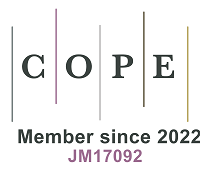REFERENCES
1. Dueñas-Moreno J, Mora A, Kumar M, Meng XZ, Mahlknecht J. Worldwide risk assessment of phthalates and bisphenol A in humans: the need for updating guidelines. Environ Int 2023;181:108294.
2. Meeker JD, Ferguson KK. Urinary phthalate metabolites are associated with decreased serum testosterone in men, women, and children from NHANES 2011-2012. J Clin Endocrinol Metab 2014;99:4346-52.
3. Laws MJ, Neff AM, Brehm E, Warner GR, Flaws JA. Endocrine disrupting chemicals and reproductive disorders in women, men, and animal models. Adv Pharmacol 2021;92:151-90.
4. Heindel JJ. The developmental basis of disease: update on environmental exposures and animal models. Basic Clin Pharmacol Toxicol 2019;125 Suppl 3:5-13.
5. Braun JM, Sathyanarayana S, Hauser R. Phthalate exposure and children’s health. Curr Opin Pediatr 2013;25:247-54.
6. Fan Y, Qin Y, Chen M, et al. Prenatal low-dose DEHP exposure induces metabolic adaptation and obesity: role of hepatic thiamine metabolism. J Hazard Mater 2020;385:121534.
7. Su H, Yuan P, Lei H, et al. Long-term chronic exposure to di-(2-ethylhexyl)-phthalate induces obesity via disruption of host lipid metabolism and gut microbiota in mice. Chemosphere 2022;287:132414.
8. Martín-Carrasco I, Carbonero-Aguilar P, Dahiri B, Moreno IM, Hinojosa M. Comparison between pollutants found in breast milk and infant formula in the last decade: a review. Sci Total Environ 2023;875:162461.
9. Liu L, Wang H, Li X, et al. Infantile phthalate metabolism and toxico/pharmacokinetic implications within the first year of life. Environ Int 2020;144:106052.
10. Liu Y, Xiao M, Huang K, et al. Phthalate metabolites in breast milk from mothers in Southern China: occurrence, temporal trends, daily intake, and risk assessment. J Hazard Mater 2024;464:132895.
11. Krithivasan R, Miller GZ, Belliveau M, et al. Analysis of ortho-phthalates and other plasticizers in select organic and conventional foods in the United States. J Expo Sci Environ Epidemiol 2023;33:778-86.
12. Kim JH, Moon N, Ji E, Moon HB. Effects of postnatal exposure to phthalate, bisphenol a, triclosan, parabens, and per- and poly-fluoroalkyl substances on maternal postpartum depression and infant neurodevelopment: a korean mother-infant pair cohort study. Environ Sci Pollut Res Int 2023;30:96384-99.
13. Lambré C, Barat Baviera JM, Bolognesi C, et al; EFSA Panel on Food Contact Materials, Enzymes and Processing Aids (CEP). Identification and prioritisation for risk assessment of phthalates, structurally similar substances and replacement substances potentially used as plasticisers in materials and articles intended to come into contact with food. EFSA J 2022;20:e07231.
14. Laccetta G, Di Chiara M, Cardillo A, De Nardo MC, Terrin G. The effects of industrial chemicals bonded to plastic materials in newborns: a systematic review. Environ Res 2023;239:117298.
15. Guilloteau P, Zabielski R, Hammon HM, Metges CC. Nutritional programming of gastrointestinal tract development. Is the pig a good model for man? Nutr Res Rev 2010;23:4-22.
16. Heinritz SN, Mosenthin R, Weiss E. Use of pigs as a potential model for research into dietary modulation of the human gut microbiota. Nutr Res Rev 2013;26:191-209.
17. Zhou C, Gao L, Flaws JA. Exposure to an environmentally relevant phthalate mixture causes transgenerational effects on female reproduction in mice. Endocrinology 2017;158:1739-54.
18. Gill S, Brehm E, Leon K, Chiu J, Meling DD, Flaws JA. Prenatal exposure to an environmentally relevant phthalate mixture alters ovarian steroidogenesis and folliculogenesis in the F1 generation of adult female mice. Reprod Toxicol 2021;106:25-31.
19. Lee Y, Rattan S, Barakat R, et al. Early postnatal exposure to di(2-ethylhexyl) phthalate causes sex-specific disruption of gonadal development in pigs. Reprod Toxicol 2021;105:53-61.
20. National Research Council (US) Committee for the Update of the Guide for the Care and Use of Laboratory Animals. Guide for the care and use of laboratory animals, 8th edition. Washington (DC): National Academies Press (US); 2011. Available from: https://www.ncbi.nlm.nih.gov/books/NBK54050/. [Last accessed on 14 Aug 2024].
21. Den Braver-Sewradj SP, Piersma A, Hessel EVS. An update on the hazard of and exposure to diethyl hexyl phthalate (DEHP) alternatives used in medical devices. Crit Rev Toxicol 2020;50:650-72.
23. Chiang C, Lewis LR, Borkowski G, Flaws JA. Exposure to di(2-ethylhexyl) phthalate and diisononyl phthalate during adulthood disrupts hormones and ovarian folliculogenesis throughout the prime reproductive life of the mouse. Toxicol Appl Pharmacol 2020;393:114952.
24. Hartke JL, Monaco MH, Wheeler MB, Donovan SM. Effect of a short-term fast on intestinal disaccharidase activity and villus morphology of piglets suckling insulin-like growth factor-I transgenic sows. J Anim Sci 2005;83:2404-13.
25. Dudley MA, Jahoor F, Burrin DG, Reeds PJ. Brush-border disaccharidase synthesis in infant pigs measured in vivo with [2H3]leucine. Am J Physiol 1994;267:G1128-34.
26. Warner GR, Li Z, Houde ML, et al. Ovarian metabolism of an environmentally relevant phthalate mixture. Toxicol Sci 2019;169:246-59.
27. Li M, Bauer LL, Chen X, et al. Microbial composition and in vitro fermentation patterns of human milk oligosaccharides and prebiotics differ between formula-fed and sow-reared piglets. J Nutr 2012;142:681-9.
28. Callahan BJ, Wong J, Heiner C, et al. High-throughput amplicon sequencing of the full-length 16S rRNA gene with single-nucleotide resolution. Nucleic Acids Res 2019;47:e103.
29. Callahan BJ, McMurdie PJ, Rosen MJ, Han AW, Johnson AJ, Holmes SP. DADA2: high-resolution sample inference from Illumina amplicon data. Nat Methods 2016;13:581-3.
30. Bolyen E, Rideout JR, Dillon MR, et al. Reproducible, interactive, scalable and extensible microbiome data science using QIIME 2. Nat Biotechnol 2019;37:852-7.
31. Smith BN, Hannas M, Orso C, et al. Dietary osteopontin-enriched algal protein as nutritional support in weaned pigs infected with F18-fimbriated enterotoxigenic Escherichia coli. J Anim Sci 2020;98:skaa314.
32. Bokulich NA, Kaehler BD, Rideout JR, et al. Optimizing taxonomic classification of marker-gene amplicon sequences with QIIME 2’s q2-feature-classifier plugin. Microbiome 2018;6:90.
33. Pedregosa F, Varoquau, G, Gramfort A, et al. Scikit-learn: machine learning in python. J Mach Learn Res 2011;12:2825-30. Available from: https://dl.acm.org/doi/pdf/10.5555/1953048.2078195. [Last accessed on 14 Aug 2024]
34. Quast C, Pruesse E, Yilmaz P, et al. The SILVA ribosomal RNA gene database project: improved data processing and web-based tools. Nucleic Acids Res 2013;41:D590-6.
35. Love MI, Huber W, Anders S. Moderated estimation of fold change and dispersion for RNA-seq data with DESeq2. Genome Biol 2014;15:550.
36. Hagerty SL, Hutchison KE, Lowry CA, Bryan AD. An empirically derived method for measuring human gut microbiome alpha diversity: demonstrated utility in predicting health-related outcomes among a human clinical sample. PLoS One 2020;15:e0229204.
37. Rattan S, Brehm E, Gao L, Flaws JA. Di(2-Ethylhexyl) phthalate exposure during prenatal development causes adverse transgenerational effects on female fertility in mice. Toxicol Sci 2018;163:420-9.
38. Chiu K, Bashir ST, Gao L, et al. Subacute exposure to an environmentally relevant dose of di-(2-ethylhexyl) phthalate during gestation alters the cecal microbiome, but not pregnancy outcomes in mice. Toxics 2021;9:215.
39. de Freitas T, Zapaterini JR, Moreira CM, et al. Prenatal exposure to a mixture of different phthalates increases the risk of mammary carcinogenesis in F1 female offspring. Food Chem Toxicol 2021;156:112519.
40. Ljungvall K, Veeramachaneni DN, Hou M, Hultén F, Magnusson U. Morphology and morphometry of the reproductive organs in prepubertal and postpubertal male pigs exposed to di(2-ethylhexyl) phthalate before puberty: precocious development of bulbourethral glands. Theriogenology 2008;70:984-91.
41. Spjuth L, Saravia F, Johannisson A, Lundeheim N, Rodríguez-Martínez H. Effects of exposure of pre-pubertal boars to di(2-ethylhexyl) phthalate on their frozen-thawed sperm viability post-puberty. Andrologia 2006;38:186-94.
42. Su PH, Chang YZ, Chang HP, et al. Exposure to di(2-ethylhexyl) phthalate in premature neonates in a neonatal intensive care unit in Taiwan. Pediatr Crit Care Med 2012;13:671-7.
43. Yang YN, Yang YSH, Lin IH, et al. Phthalate exposure alters gut microbiota composition and IgM vaccine response in human newborns. Food Chem Toxicol 2019;132:110700.
44. Zhang YJ, Guo JL, Xue JC, Bai CL, Guo Y. Phthalate metabolites: characterization, toxicities, global distribution, and exposure assessment. Environ Pollut 2021;291:118106.
45. Wang G, Chen Q, Tian P, et al. Gut microbiota dysbiosis might be responsible to different toxicity caused by di-(2-ethylhexyl) phthalate exposure in murine rodents. Environ Pollut 2020;261:114164.
46. Yu J, Wang W, Wang J, Wang C, Li C. Short-term toxicity of dibutyl phthalate to mice intestinal tissue. Toxicol Ind Health 2019;35:20-31.
47. Yang TN, Li XN, Li XW, Li JY, Huang YQ, Li JL. DEHP triggers a damage severity grade increase in the jejunum in quail (Coturnix japonica) by disturbing nuclear xenobiotic receptors and the Nrf2-mediated defense response. Environ Toxicol Pharmacol 2022;96:104012.
48. Ahmed K, Kharoubi O, Aoues AEK, Bouchekara M, Khaladi B, Taleb M. Effect of gestational and lactational exposure to DEHP, DINP, and DEP on intestinal morphology, disaccharidases, and alkaline phosphatase in rats during postnatal development. Am J Perinatol 2018;35:1251-9.
49. Beumer J, Clevers H. Cell fate specification and differentiation in the adult mammalian intestine. Nat Rev Mol Cell Biol 2021;22:39-53.
50. Shum TF, Wang L, Chiou J. Impact of plasticizer on the intestinal epithelial integrity and tissue-repairing ability within cells in the proximity of the human gut microbiome. Int J Environ Res Public Health 2023;20:2152.
51. Chiu KK, Bashir ST, Abdel-Hamid AM, et al. Isolation of DiNP-degrading microbes from the mouse colon and the influence DiNP exposure has on the microbiota, intestinal integrity, and immune status of the colon. Toxics 2022;10:75.
52. Davis EC, Dinsmoor AM, Wang M, Donovan SM. Microbiome composition in pediatric populations from birth to adolescence: impact of diet and prebiotic and probiotic interventions. Dig Dis Sci 2020;65:706-22.
53. Wang M, Monaco MH, Donovan SM. Impact of early gut microbiota on immune and metabolic development and function. Semin Fetal Neonatal Med 2016;21:380-7.
54. Liu Z, Liu M, Wang H, et al. Glutamine attenuates bisphenol A-induced intestinal inflammation by regulating gut microbiota and TLR4-p38/MAPK-NF-κB pathway in piglets. Ecotoxicol Environ Saf 2024;270:115836.
55. Lei M, Menon R, Manteiga S, et al. Environmental chemical diethylhexyl phthalate alters intestinal microbiota community structure and metabolite profile in mice. mSystems 2019;4:e00724-19.
56. Cheng X, Chen J, Guo X, et al. Disrupting the gut microbiota/metabolites axis by di-(2-ethylhexyl) phthalate drives intestinal inflammation via AhR/NF-κB pathway in mice. Environ Pollut 2024;343:123232.
57. Wang M, Radlowski EC, Li M, Monaco MH, Donovan SM. Feeding mode, but not prebiotics, affects colonic microbiota composition and volatile fatty acid concentrations in sow-reared, formula-fed, and combination-fed piglets. J Nutr 2019;149:2156-63.
58. Fu X, Han H, Li Y, et al. Di-(2-ethylhexyl) phthalate exposure induces female reproductive toxicity and alters the intestinal microbiota community structure and fecal metabolite profile in mice. Environ Toxicol 2021;36:1226-42.
59. Quan J, Cai G, Ye J, et al. A global comparison of the microbiome compositions of three gut locations in commercial pigs with extreme feed conversion ratios. Sci Rep 2018;8:4536.
60. Waters JL, Ley RE. The human gut bacteria Christensenellaceae are widespread, heritable, and associated with health. BMC Biol 2019;17:83.
61. Goodrich JK, Waters JL, Poole AC, et al. Human genetics shape the gut microbiome. Cell 2014;159:789-99.
62. Lee-Sarwar KA, Kelly RS, Lasky-Su J, et al. Integrative analysis of the intestinal metabolome of childhood asthma. J Allergy Clin Immunol 2019;144:442-54.
63. Wang HG, Zhang MN, Wen X, et al. Cepharanthine ameliorates dextran sulphate sodium-induced colitis through modulating gut microbiota. Microb Biotechnol 2022;15:2208-22.
64. Chai X, Wen L, Song Y, et al. DEHP exposure elevated cardiovascular risk in obese mice by disturbing the arachidonic acid metabolism of gut microbiota. Sci Total Environ 2023;875:162615.
65. Wu X, Zhang T, Zhang T, Park S. The impact of gut microbiome enterotypes on ulcerative colitis: identifying key bacterial species and revealing species co-occurrence networks using machine learning. Gut Microbes 2024;16:2292254.
66. Tian Y, Fu M, Su J, et al. Gut microbiota dysbiosis and intestinal barrier impairment in diarrhea caused by cold drink and high-fat diet. Toxicology 2024;502:153728.
67. Nazina TN, Bidzhieva SK, Grouzdev DS, Löffler FE. Sphaerochaeta. In: Whitman WB, editor. Bergey’s manual of systematics of archaea and bacteria. Wiley; 2015. pp. 1-13.
68. Blaak EE, Canfora EE, Theis S, et al. Short chain fatty acids in human gut and metabolic health. Benef Microbes 2020;11:411-55.
69. Ghosh S, Pramanik S. Structural diversity, functional aspects and future therapeutic applications of human gut microbiome. Arch Microbiol 2021;203:5281-308.
70. El-Salhy M. Intestinal bacteria associated with irritable bowel syndrome and chronic fatigue. Neurogastroenterol Motil 2023;35:e14621.
71. Toubon G, Butel MJ, Rozé JC, et al. Association between gut microbiota at 3.5 years of age and body mass index at 5 years: results from two French nationwide birth cohorts. Int J Obes 2024;48:503-11.







